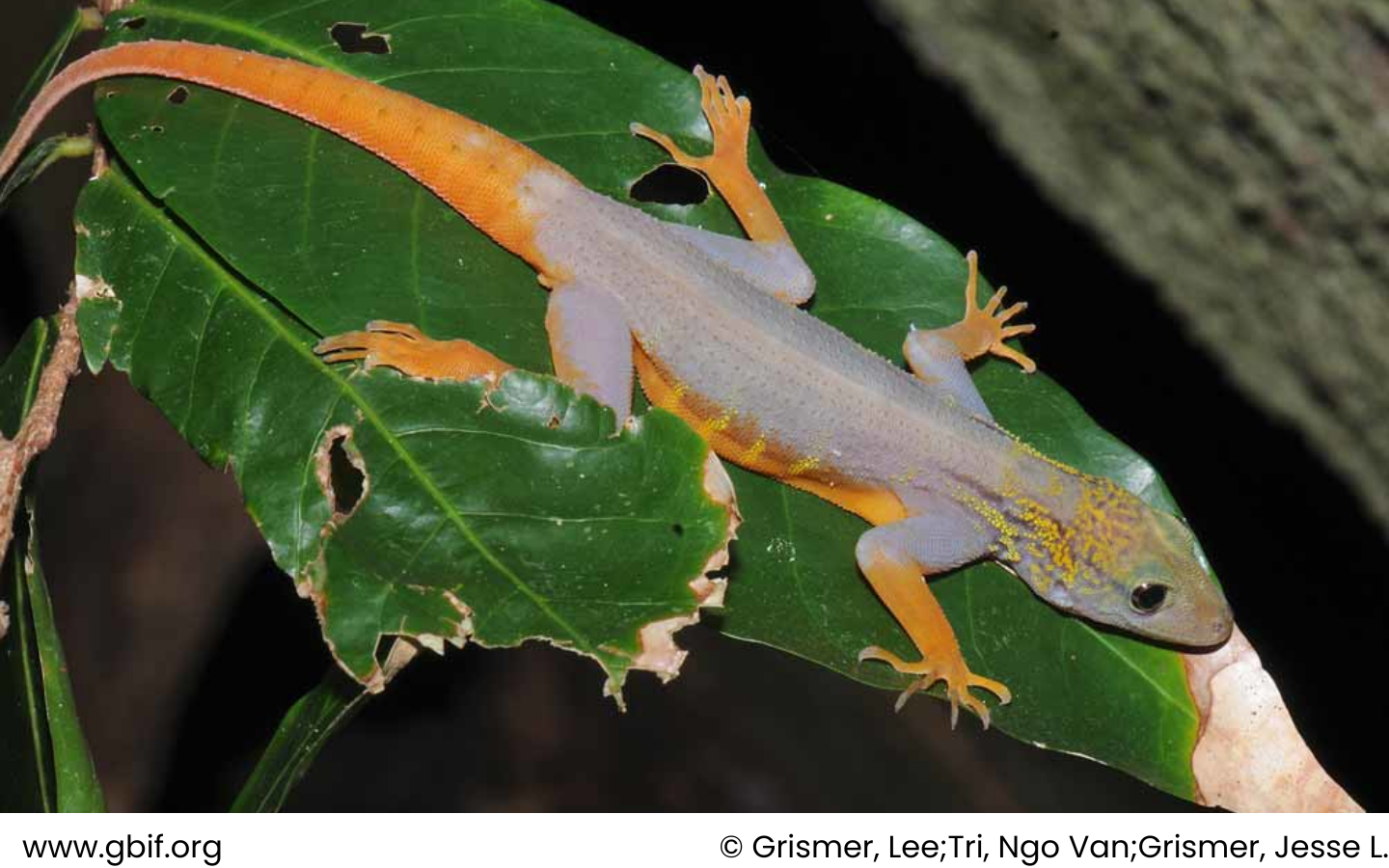
Science name: Cnemaspis psychedelica – Grismer, Ngo & Grismer, 2010
Taxonomic: Animalia>> Chordata>> Reptilia>> Squamata >> Gekkonidae >> psychedelica
Species status: Endemic ; IUCN status: EN (Endangered Species)
Description:
Physical characteristics: Adults have a maximum snout-vent length (SVL) of at least 75.3 mm for males and 72.2 mm for females. The species has 7 or 8 supralabials and 5–7 infralabials, very large mental scales followed by three postmental scales, and smooth ventral, subtibial, and subcaudal scales. The dorsal forearm scales and dorsal tubercles are keeled. Caudal tubercles are restricted to single paravertebral rows.
Coloration: The species exhibits bright and distinctive coloration, with bright-orange forelimbs, hands, feet, and tail, along with bright-orange flanks bearing three to four yellow transverse bars. The neck features a bright-yellow reticulum overlaid with thick black streaks, and the head is greenish in color. This vibrant patterning is present across all age groups and both sexes.
Distribution and habitat:
Elevation: Found at elevations ranging from 3 to 300 meters.
Area: Endemic to Hon Khoai Island and Hon Tuong Isle, Ca Mau Province, southern Vietnam. The species is restricted to these two small islands in the Rach Gia Bay, with Hon Khoai Island covering an area of only about 8 km².
Habitat: Cnemaspis psychedelica inhabits granite boulders in the shade of forest canopies, preferring large boulders surrounded by dense vegetation. Individuals are frequently found retreating into cracks in rocks or beneath ledges when threatened. They are also observed basking in filtered sunlight during the day. At night, they rest below overhanging boulders or retreat into crevices.
Behaviour and ecology:
Lifestyle: Cnemaspis psychedelica is diurnal but can also be active at night. During the day, individuals bask in filtered sunlight, and at night, they sleep on leaves or retreat into rock crevices. They are often observed in groups composed of different age and sex classes.
Reproduction: Oviparous, with gravid females observed carrying two eggs. Eggs are deposited under overhanging boulders, sometimes in aggregations.
Diet: The species feeds on insects found within its habitat.
Conservation and status:
IUCN Red List Category and Criteria: Endangered B1ab(iii)+2ab(iii)
Threats: Cnemaspis psychedelica faces significant threats from habitat loss due to development and potential predation by introduced monkeys on its small island habitats. The species is also at risk from illegal collection for the pet trade, where it is highly sought after by international hobbyists due to its striking appearance. Ongoing habitat degradation and illegal harvest threaten the survival of this species, requiring conservation actions to prevent further declines.
Crocodile Trail – The Best Birding Trail in Cat Tien National Park
If you’re a birder or nature photographer planning a trip to Vietnam, few places offer [...]
Cong Troi Trail – Top 1 Dalat Plateau Birding Trail Experience
If you’re a birder or nature photographer planning a trip to Vietnam’s Central Highlands, the [...]
How to Identify the Greater Sand Plover, Tibetan Sand Plover and Siberian Sand Plover
Identification Differences within the Sand Plover Complex: The sand plover group, which was traditionally divided [...]
Highlights of Cat Tien National Park Reptiles and Amphibian Endemics
Spanning over 71,350 hectares of tropical forests, grasslands, and wetlands, Cat Tien National Park is [...]
Highlights of Cat Tien National Park Mammals in a World Biosphere Reserve
In addition to reptiles and birds, Cat Tien National Park is also rich in mammals, [...]
Kontum Plateau Endemic and Highlight bird
Kontum Plateau Endemic And Highlight Bird species like Chestnut-eared Laughingthrush and top birding routes while [...]